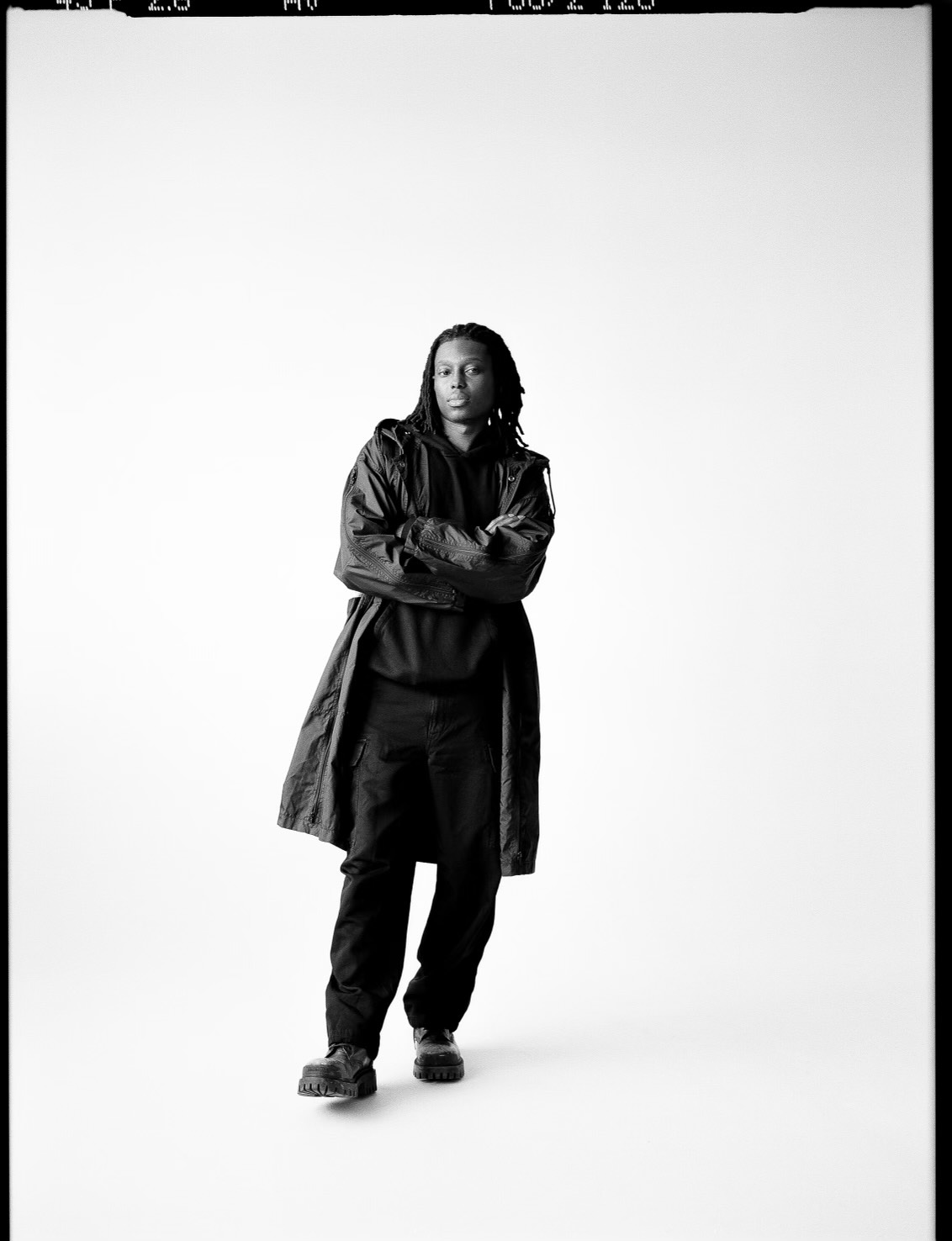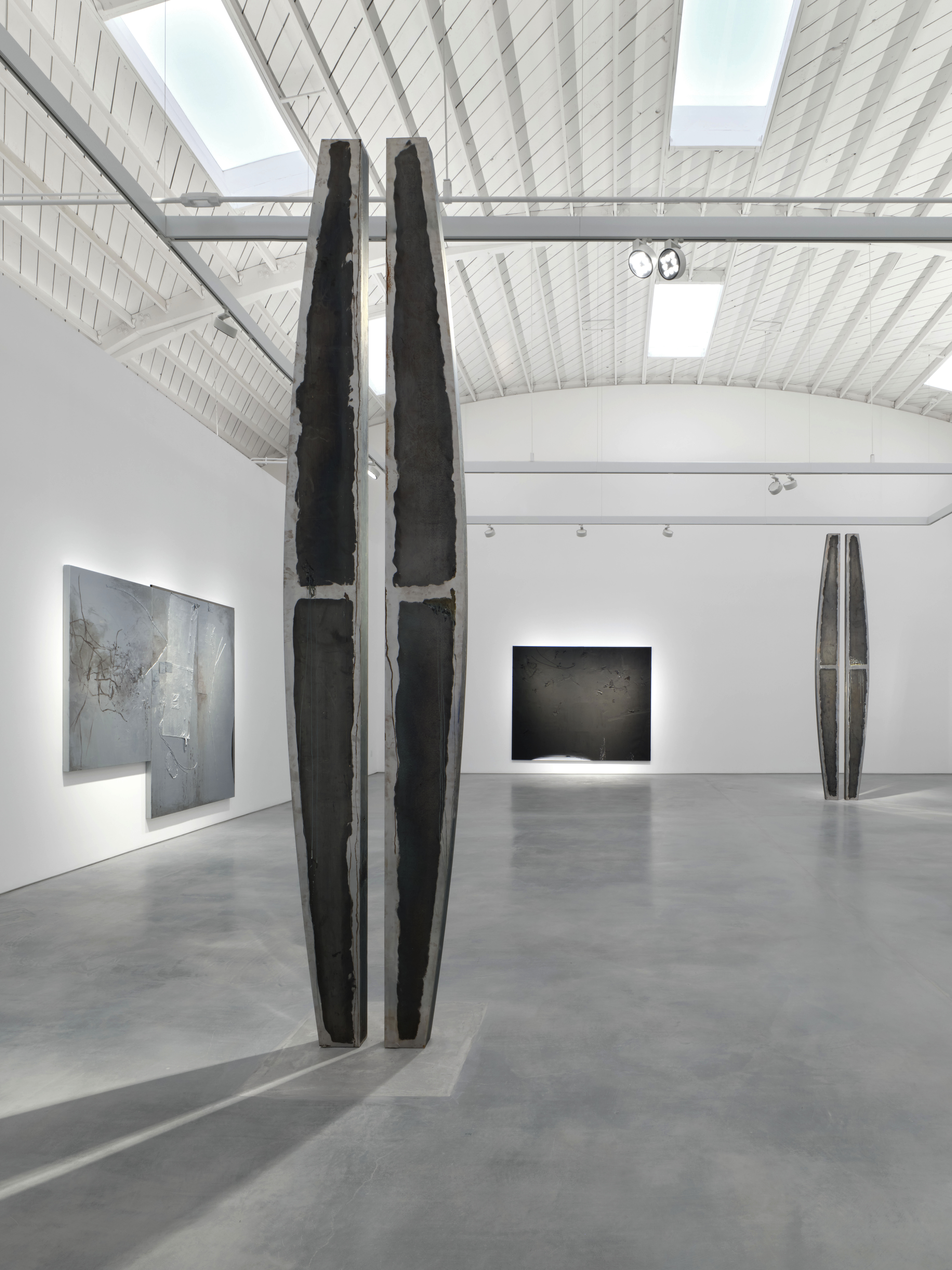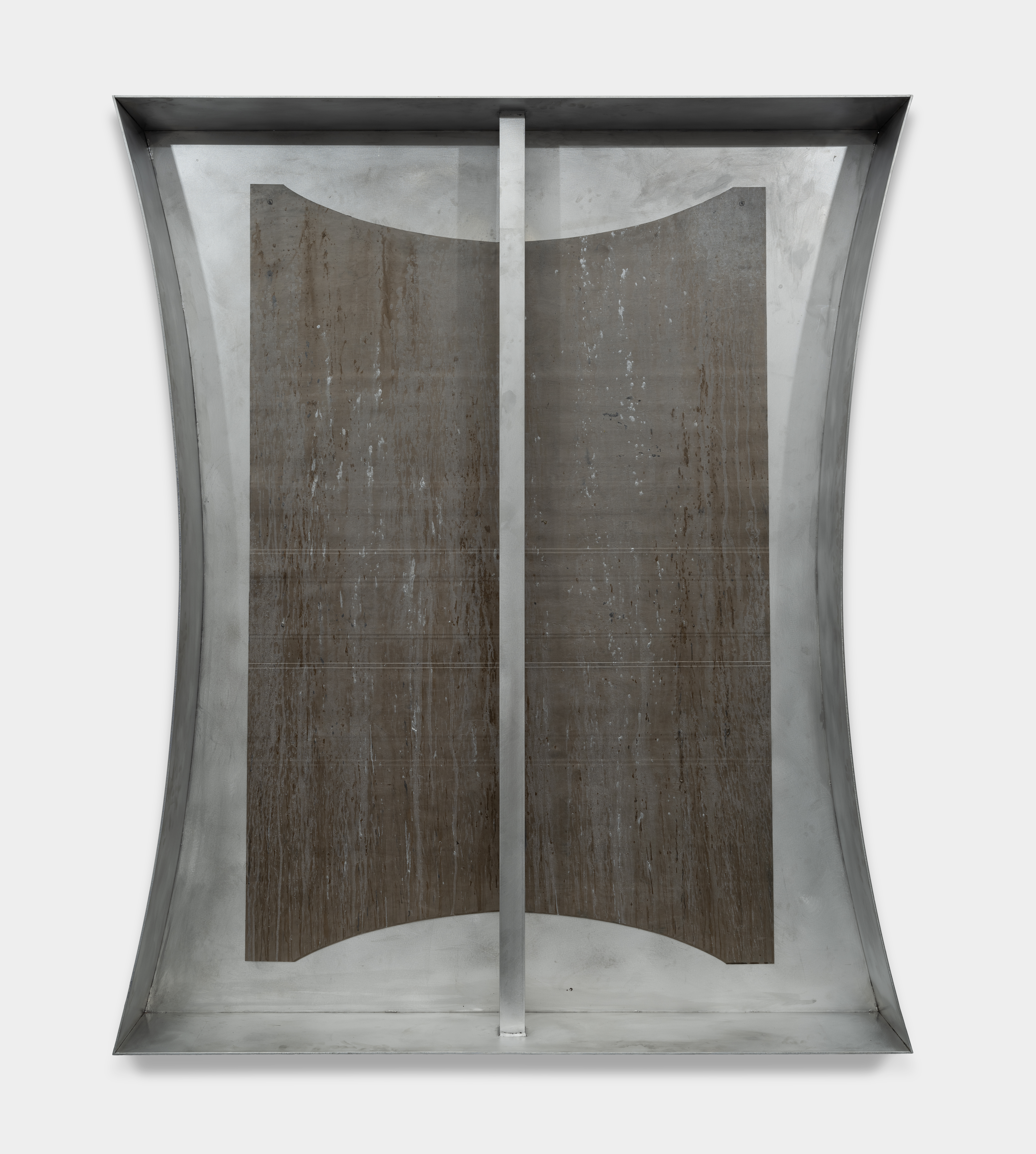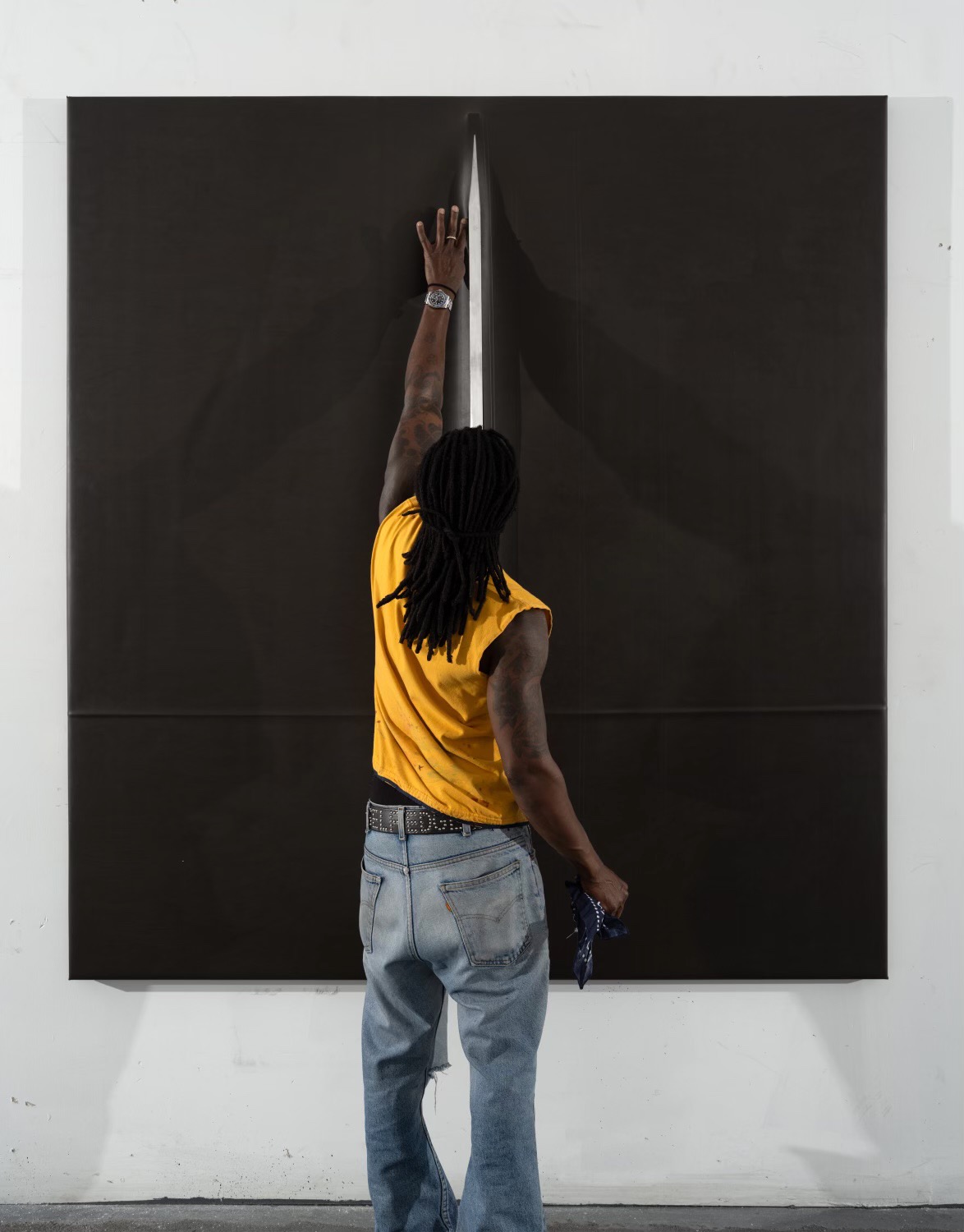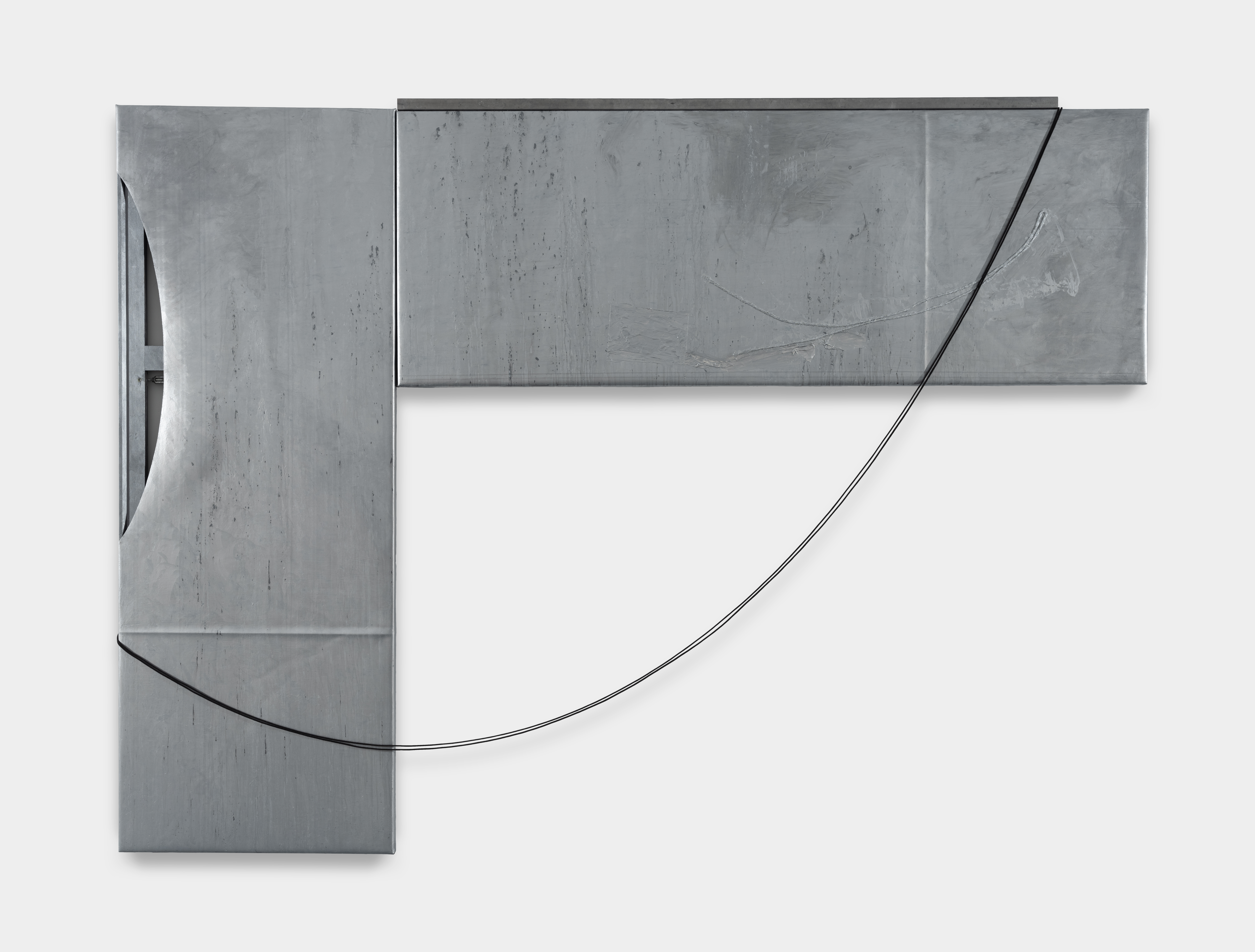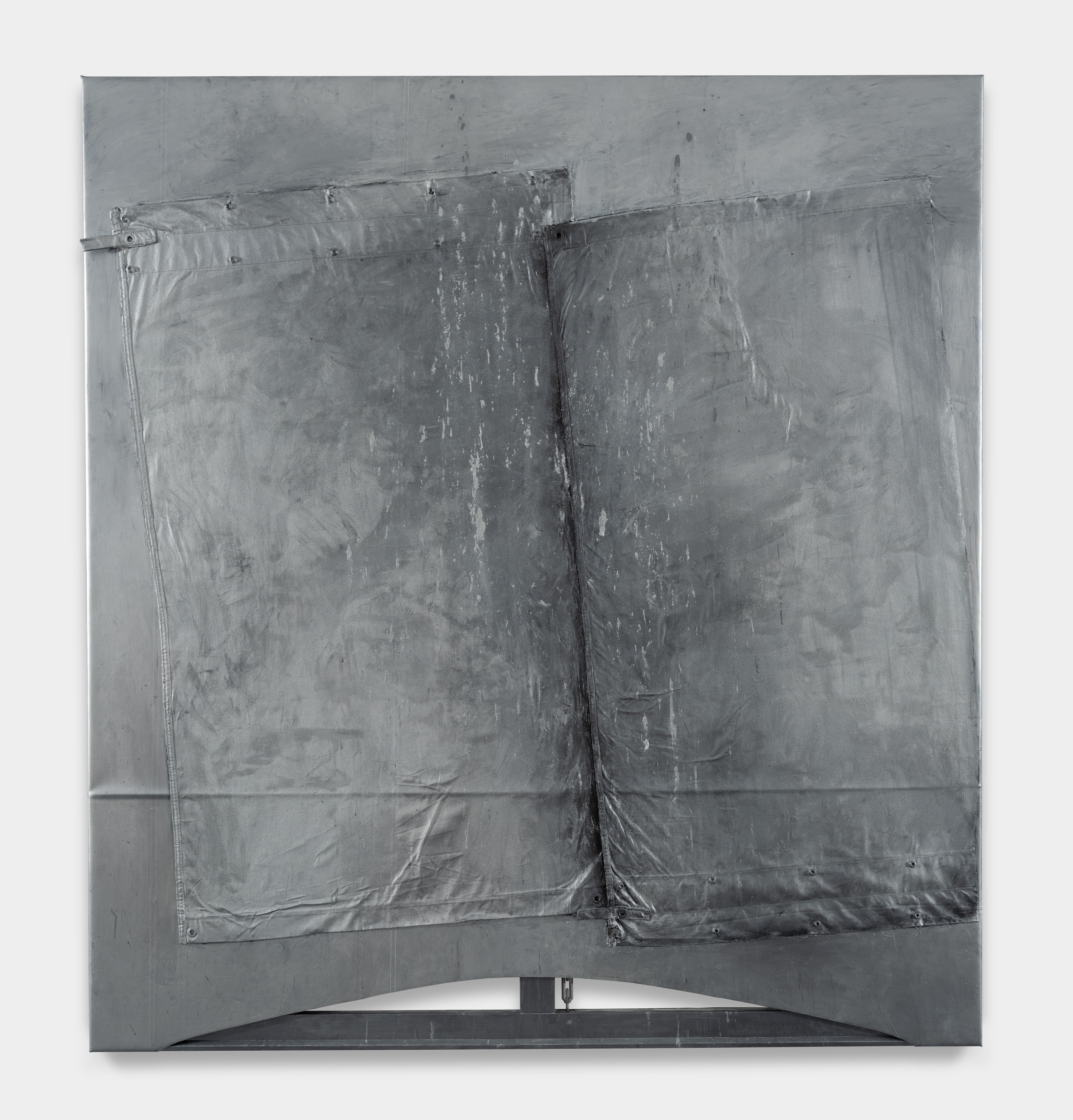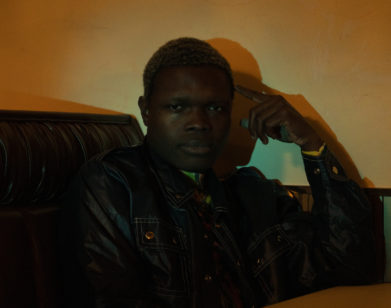STEEL
Reginald Sylvester II Opens the Gates to His Brutalist Heaven
Reginald Sylvester II is weaving his own Afrofuturist matrix. The Bay area-raised artist opened two new shows in November: Sensibilities, a group show at London’s Maximillian William, and T-1000, a solo exhibition at Roberts Projects in Los Angeles. The latter follows through on its titular nod to the Terminator 2 android assassin in a series of works combining chrome, rubber, military tarp, and random debris in a moody material reckoning with authoritarianism and Black history. The show also extends Sylvester’s foray into sculpture, featuring two towering steel gates that bring the Biblical references in the iconic dystopian film full-circle. “You have a language that really is your own, Reggie,” curator K.O. Nnamdie tells him of the growth they’ve witnessed since the two first met, as they hop on a call to talk spirituality, the OGs of sculpture, and chopped and screwed remixes. “People can notice your work from a mile away.”
———
REGINALD SYLVESTER II: Yo, what’s goodie?
K.O. NNAMDIE: How’s everything on your end?
SYLVESTER II: Tired.
NNAMDIE: Yeah, you opened two shows this week. Congratulations, Reggie. That’s amazing.
SYLVESTER II: I appreciate that, K.O. I want to see that show in London before it closes.
NNAMDIE: I mean, paired with David Hammons, that’s really outstanding.
SYLVESTER II: Thank you, it’s crazy.
NNAMDIE: I’d love to start with how T-1000 came about. How long were you working on this show for?
SYLVESTER II: I never necessarily make for a show in particular, but I landed on this body of work after making the works for the Kemper Museum, the Green Gate paintings. Once those gate sculptures came into the studio, it made me want to make paintings that were directly in relation to the sculptures and their steel surfaces. I was already on that path in my series of paintings titled Industrial Paintings on gray backgrounds, but the palette that I was using was still very colorful. The sculptures made me pull back and work more in a controlled palette and monochromatic way. I started using all these iridescent steel tones to reflect the materials that I was working with. That’s when the work started to turn into what T-1000 is today.
NNAMDIE: I was really amazed to see this show because of your deployment of those colors. I know that the gray and silver has to do with the film Terminator a bit, but were you also thinking at all about clouds? The color gray feels like an in-between state between white and blue.
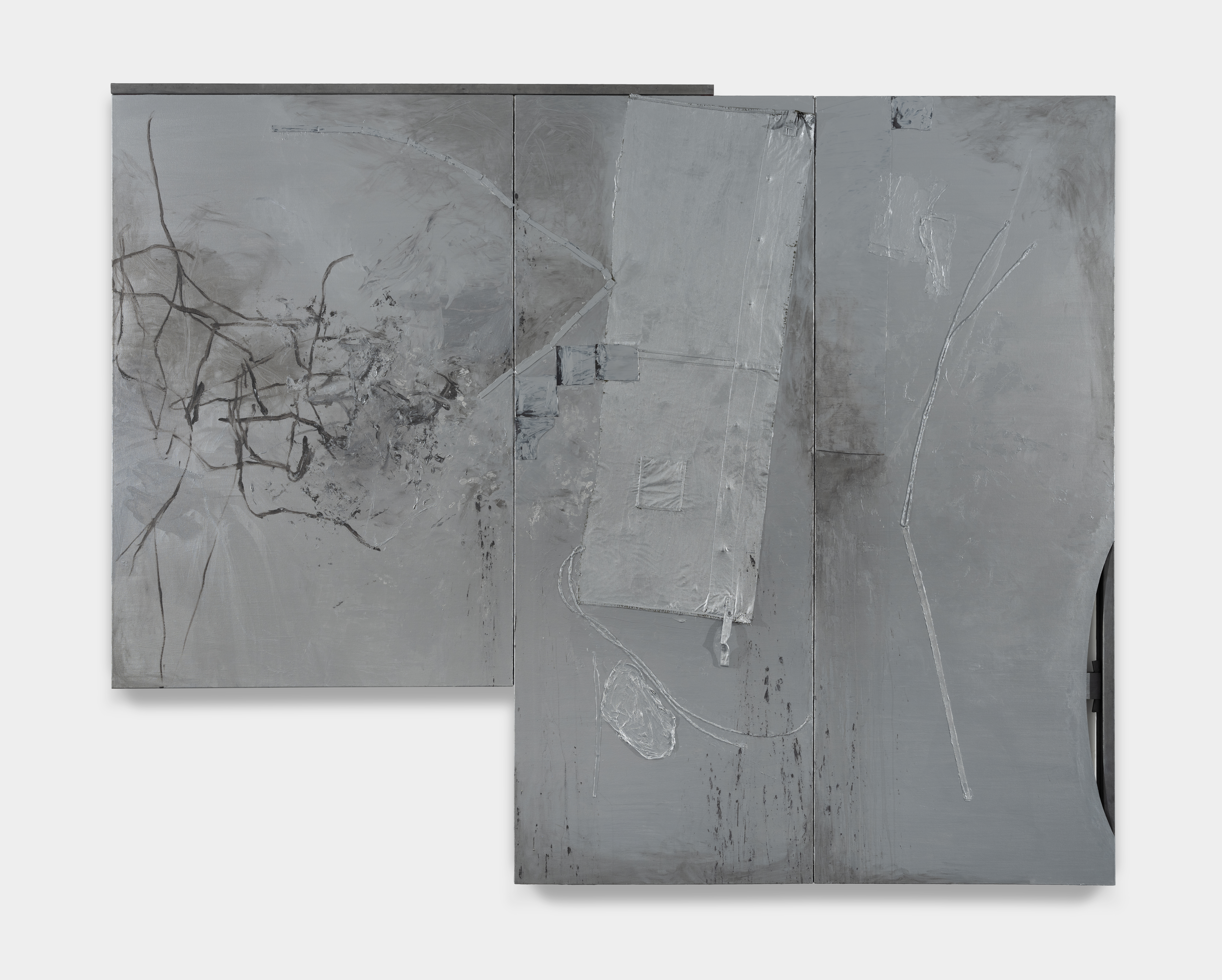
Ridgewood, 2023. Acrylic, rubber, studio debris and steel beam on canvas over exposed substrate. All artwork images by Daniel Greer.
SYLVESTER II: It’s funny, because I post a lot of images of clouds on my ‘gram, so that could have been an unconscious thing. I went through a stage where I was making ten drawings every morning just to build a personal relationship with the line. I started to notice certain things in nature that I wanted to riff off of in order to create a language with line. So back to your question about clouds or gray skies, a lot of that reference material was coming from lightning steels. I was referencing that as well as cracks in the cement. Your question makes me think about the layer of skyscape in the paintings and their gestural nature. Somebody asked me yesterday where the cord came in on one of the works. I was telling them about telephone poles and cables and the way that some of them swing or drape and aren’t pulled as straight. So when I think about the skyscape, it’s maybe incorporating my environment outside of just the industrial environment, like the weather conditions or what it’s like at the edge of the city.
NNAMDIE: I’m happy to hear you recall nature showing up in some works. I think we’re never not touching nature and your work feels like you are really submerging yourself into the elements. And I kept coming back to these forms that you’re mentioning that are like gates, and thinking of them almost as ancestors or something.
SYLVESTER II: Yeah, those gate forms are both very ancestral and futurist. Those came to be because I keep all the byproducts and the waste from the paintings. When I laid those leftover shapes on the ground, they reminded me of the floor plans of the boats from the transatlantic slave trade. So I thought about our ancestors who were on those ships who jumped over, our ancestors who have passed going back to god, and thinking about those gates of heaven. I felt like if I take these oppressive forms and elevate them, it changes their relationship. It transforms them into something more spiritual or into a totem of sorts.
NNAMDIE: One work that really jumped out at me is “Ridgewood.” It incorporates the exposed substrate as well as studio debris. Could you speak a little bit about that?
SYLVESTER II: I titled it “Ridgewood” because that’s where my studio is. “Ridgewood” is a special painting because it encompasses all my interests as a maker. I love readymades, I love sculpture, I love conceptual art, but at heart, I’m a painter. This was me trying to confront all these different interests. I’m also using every material I’ve ever used before. It exists on canvas, but there’s rubber there. There’s military tent shell there that pays tribute to the refuge paintings I’ve made. There’s this assemblage and there’s the conceptuality of revealing the substrate. It’s a way for me to speak to my interests in my process of making, so it’s a very special work for me.
NNAMDIE: You’re from the Bay Area. How does it feel to be showing a body of work like this in your hometown?
SYLVESTER II: It was crazy. There are a lot of different layers. My dad is from Chicago, and we have a lot of family in the deep south in Natchez, Mississippi, but his mom’s side is all here in L.A. All my Bay Area family got to come. A lot of friends that I came up with were here. I got to touch all these different layers of people that have been supporting me for such a long time. Then the location fit the concept of the show, which I was super stoked about, because Terminator took place in Los Angeles. New York has groomed me as a person and as an artist too, so I wanted to bring some of that New York energy that I love to this. So we have beautiful skies and sunshine in L.A., and you walk into this monochromatic show and bring some of that heaviness, that grit you get from the city.
NNAMDIE: The heaviness feels both soft and hard at the same time. It oscillates between those two things so poetically. You also play with scale very well. Should we be looking forward to seeing more works that are in this large scale?
SYLVESTER II: Absolutely. I’m not by trade a sculptor, but I always have had an interest in making sculpture. It’s my first time, and I was dying to make something you got to work the body and lift your head up to look at. I’m sure most sculptors work gradually to that place, but I like to just leap right in. Making the show has opened up a lot of ideas. I want to continue to expand and make larger and larger scale works.
NNAMDIE: Your work is always very monumental, but now it feels like there’s a beautiful maturity in them. I’m quite actually taken aback by the show. Did you make this in collaboration with someone or were you welding these works yourself?
SYLVESTER II: No, I work with a foundry out in Connecticut. I was fortunate enough to meet this cat named Siebren [Veersteg]. He’s an artist himself, and his father actually founded their foundry. I come to him with sketches and concepts and he helps me make them possible, especially on the engineering side. They do the welding, and then I come in after. I take a lot of trips up to CT to see it through the process, but I never want to control the material. I like that I’m able to build a relationship and a dialogue with the foundry. When things naturally happen from making the forms, I like to make the decision whether I want to keep those natural things or change them. For instance, the mill scale was something I didn’t anticipate. Those darker areas on the gates come from the natural state of the material, and you can sandblast that out. It takes a long time, but you can. But once I seen it, I said, “This mill scale is so beautiful and harsh at the same time. I want to keep it.” I want to make paintings in relation to the mill scale. I do all the patina myself, so they crane me up and I work with the oxidation mediums to really try and treat the forms like paintings.
NNAMDIE: They are very much in dialogue with the paintings. I want to talk about your evolution from the time that I came to know your work. It’s been a long time coming. You’ve mentioned wanting to make some public art in the future, and I’d love to see your work in a public sculpture garden. I think kids and families would love to interface with your work. It feels very community-oriented in general. Where do you see the work going next?
SYLVESTER II: I want to become a respected sculptor. I’m starting to fall in love with making three-dimensional things outside of paintings. These next shows that I have coming up involve two parts of my practice that—William T. Williams told me not to use the word “practice.” He said, “There is no more practice, it’s game time.”
NNAMDIE: You’ve been in the game. We know that.
SYLVESTER II: [Laughs] Yeah. The next solo show that I would have, I almost don’t want to have any paintings, maybe one. I’ll always make paintings. Painting is like living. But sculpture has made way for me to look at drawing in a certain way.
NNAMDIE: It’s fantastic that you’re very fluid and intuitive in your practice. There’s motifs in your work that I’ve seen repeated a few times, like the incision that happens on the surface of the work. It’s a very interesting decision. Is this a way of making an opening for something to come in?
SYLVESTER II: I watched this really cool 60 Minutes interview with Richard Serra. He talked about his admiration for [Alberto] Giacometti and how he was like that guy in his time. Giacometti’s still a great OG, but Serra had opened up a new lane that changed the relationship between the person and the object where the sculpture became space and the person became the object. Serra was grappling beyond just sculpture, he’s grappling with architecture. I really thought about that. How can I make the viewer want to move beyond just the surface? These incisions allow me to do that.
NNAMDIE: They give us permission to get curious.
SYLVESTER II: The eye moves past the surface. Now you’re faced with the substrate and the wall. It’s forced you to not only think about the structure of the painting, but the structure of the space that you’re in too. Making those incisions opened up a lot of things for me. I had had the rubber in the studio for quite some time and didn’t really know what to do with it. Then I got brave enough to stretch it over the substrate. I actually tried to make a painting with a paintbrush, I just didn’t like the way the paint laid on the rubber because rubbers repel liquids. So I wiped away the entire painting, and I was left with this wash that looked like oxidization. I’m not going to babble too much, but during that time, I was also collecting these West African heirloom anklets that have a torqued form. It made me think of Tadao Ando and the structures that he creates. I started having a dialogue with artists that I love that I maybe never would’ve had dialogue with before. The curvature of the cut is almost like a signature now.
NNAMDIE: It grounds you into knowing that this is more than just a painting. You really allow us viewers to participate as opposed to just watching the work perform for us, which I appreciate.
SYLVESTER II: I like the way you said that.
NNAMDIE: That’s just what it is. Your language has been developing over time, and in your new work, you have a language that really is your own, Reggie. People can notice your work from a mile away. Do you have an idea of who it’s speaking to?
SYLVESTER II: First and foremost, I think the abstraction and brutalist futurism speaks to the spirit. I want to confront the battles we have spiritually first. I want to really speak to the Black and Brown experience through these spiritual moments within the work. I want the work to deal with the internal, as opposed to the external.
NNAMDIE: This show is very much looking inward and it’s a very meditative and calming exhibition given the title.
SYLVESTER II: I mean, there’s definitely political undertones that I nod at. T-1000 has this pop culture visual and this political patina. It’s crazy that T-1000 was a cop. Running around terrorizing. Those kinds of nods are great because I don’t really need to say much more if you really take the time to think about it. I still want to be on the forefront of the fight.
NNAMDIE: Of course.
SYLVESTER II: The Black and Brown experience is a tough one, and I believe us to be futurists. We are always going to be battling with the things from the past, but at the same time in the future. We deal with things a little differently.
NNAMDIE: Yeah. Your work has always been connected to the cosmos, and I’ve always thought of your work being very directly linked to Afrofuturism and talking about Blackness and Brownness in a way where it’s inviting other people to do their homework, instead of asking you as a Black person or person of color to inform us of what every gesture means.. This writer Alexis Pauline Gumbs wrote an amazing book called M Archive, which is about Afrofuturism.
SYLVESTER II: It’s dope you brought that writer up, because apparently the writer of Terminator and Matrix was a Black woman named Sophia Stewart. Watching her interviews was a big part of this show as well. She talks about her relationship with the savior figure—John Connor, Jesus Christ. She makes that tie Biblically, but at the same time, this machine was sent back in time to kill a liberator of the people. I need to tap into the writer you just named. I want to find my place in Afrofuturism. Wangechi Mutu’s show right at the New Museum was crazy. There’s something about Simone Leigh’s sculpture that feels very futurist.
NNAMDIE: For sure.
SYLVESTER II: Or even Magdalene Odundo, she’s a huge inspiration. What she does on the surface of those vessels is so incredible. I’m trying to work my way there. Shouts out to the sisters and the aunties.
NNAMDIE: Always have to give people their flowers. The works feel really feminine and masculine at the same time. And I think the darkness is a very comforting thing. There are some silvers, of course, but there’s a lot of colors that the eye can see as black.
SYLVESTER II: Yeah. Listen, melanated skin looks good with a shimmer of silver.
NNAMDIE: It does.
SYLVESTER II: I always have worn gold.
NNAMDIE: You wear gold a lot.
SYLVESTER II: Yo, K.O., I started working on this show, everything started turning silver. I’m super happy you brought that up. There’s something very iridescent about black. That melanated skin coupled with steel and metallics, I’m telling you, we’re futuristic beings.
NNAMDIE: I believe it too. This show feels like a dance. That brings me to wonder, what music are you listening to when you’re in the studio?
SYLVESTER II: So I made sound work for this show as well. It was my first time putting audio together myself. I sent it to two sound artists that I work with, my homies Anthony Jamari Thomas and Bako Seville, and they helped me flesh it out. But I’ve been listening to a lot of scores from movies. So Hans Zimmer, who scored Blade Runner 2049. The old Blade Runner film too, and the score from Dune. Also, we all know the chopped and screwed music from Texas. I was playing a lot of Marvin Gaye and Mary J. Blige’s My Life record. But then I found this chopped and screwed version of it, and—
NNAMDIE: On Soundcloud?
SYLVESTER II: On YouTube.
NNAMDIE: I love chopped and screwed.
SYLVESTER II: Then I start thinking about how futuristic Marvin Gaye’s or Mary J. Blige’s voice are, especially if you slow it down and stretch it out. So I basically took the last 38 seconds of “Inner City Blues” from Marvin Gaye, I took the chorus and a few other bits from My Life, and I made the sound work. I’ve also been listening to a lot of BADBADNOTGOOD too… Also a close homie of mine, Duckwrth. He came out with a project called Chrome Bull, and he’s on some futuristic house energy.
NNAMDIE: That’s great to hear, because as artists, we are sponges, and the work that we make are also sponges in a way. T-1000 is very high vibrational, and I love that you’ve achieved this sonic pitch.
SYLVESTER II: Appreciate that. Thank you for taking the time to talk to me, K.O.

